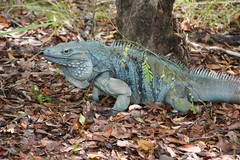 |
| Blue Iguana I (Photo credit: pjah73) |
Environmental Issues: Survival for Animals
The IUCN (International Union for Conservation of Nature) is the World Conservation Union, which is an organization that maintains a list of animals that are dangerously close to extinction on what is known as the “Red List.” The ultimate mission of the IUCN’s Red List is to provide valuable information regarding the endangered species and statistics surrounding each species. The two major goals of the Red List are to: identify and document species in need of conservation and to provide a global index regarding the species on earth (IUCN). There are many affiliates who work with IUCN in order to help them achieve their goals. According to the IUCN official website, some of the partners are: IUCN Species Programme (working closely with the IUCN Species Survival Commission), BirdLife International, the Center for Applied Biodiversity Science (CABS) at Conservation International (CI), NatureServe, and the Institute of Zoology at the Zoological Society of London.
The Red List provides a search engine of information that has been collected regarding endangered species. The List is separated into categories, such as least concern, near threatened, vulnerable, endangered, critically endangered, extinct in the wild, and extinct. There are different levels of criteria for each category.
 |
| Blue Iguana II (Photo credit: pjah73) |
 |
| English: '. (Photo credit: Wikipedia) |
References:
“The IUCN Red List of Threatened Species.” International Union for Conservation of
Publishing: San Francisco, 2009.


No comments:
Post a Comment